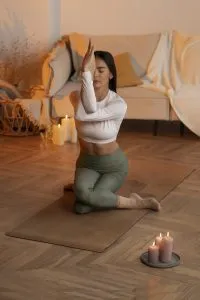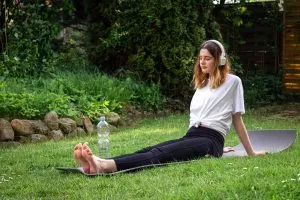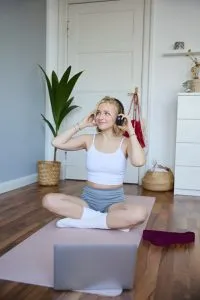Have you ever found yourself staring at the ceiling at 2 a.m., your mind racing through tomorrow’s to-do list like its training for a marathon? You’re not alone. In our fast-paced, always-on world, sleep often becomes the first casualty. But what if I told you that the secret to better sleep might be as simple as rolling out a yoga mat?
Welcome to your new nightly ritual – Yoga for Better Sleep.
Why Yoga Before Bed Works Wonders
Let’s be real—most of us don’t wind down so much as crash. We go from scrolling through our phones to tossing and turning, wondering why we can’t fall asleep. The truth is, our bodies and minds need a transition. That’s where bedtime yoga routines come in.
Yoga helps activate the parasympathetic nervous system—your body’s natural “rest and digest” mode. Through gentle movement, deep breathing, and mindfulness, yoga lowers cortisol levels, eases muscle tension, and quiets mental chatter. It’s like giving your nervous system a warm cup of chamomile tea.
I started doing a 10-minute yoga flow before bed during a particularly stressful work season. Within a week, I was falling asleep faster and waking up less groggy. It felt like magic—but it was just science and breath.
The Science Behind Yoga and Sleep
Multiple studies support the benefits of yoga for sleep:
- A 2019 study published in BMC Psychiatry found that yoga significantly improved sleep quality in adults with insomnia.
- Harvard Medical School reports that over 55% of yoga practitioners say it helps them sleep better, and 85% say it reduces stress.
Yoga isn’t just stretching—it’s a relaxation technique for sleep that works on both the body and the mind.
Best Yoga Poses for Sleep
Let’s dive into the poses that help you drift off like a baby in a hammock. These are gentle, restorative, and beginner-friendly.
1. Legs-Up-the-Wall (Viparita Karani)
This pose is like a reset button for your nervous system. Lie on your back and swing your legs up against a wall. Let your arms rest by your sides, palms up.
Benefits: Reduces swelling in the legs, calms the mind, and promotes circulation.
2. Child’s Pose (Balasana)
Kneel on the floor, sit back on your heels, and fold forward with your arms stretched out or tucked beside you.
Benefits: Releases tension in the back and shoulders, encourages deep breathing.
3. Reclining Bound Angle Pose (Supta Baddha Konasana)Lie on your back, bring the soles of your feet together, and let your knees fall open. Use pillows under your knees for support.
Benefits: Opens the hips and chest, promotes relaxation.
4. Standing Forward Bend (Uttanasana)
Stand tall, then fold forward from the hips, letting your head hang heavy.
Benefits: Calms the nervous system, stretches the spine and hamstrings.
5. Corpse Pose (Savasana)
The ultimate relaxation pose. Lie flat on your back, arms and legs relaxed, eyes closed.
Benefits: Total body relaxation, perfect for transitioning into sleep.
A Simple Bedtime Yoga Routine (10–15 Minutes)
You don’t need an hour-long session to reap the benefits. Here’s a quick bedtime yoga routine you can do in your pajamas:
- Seated Breathing (2 minutes) – Sit comfortably and take slow, deep breaths. Inhale for 4, exhale for 6.
- Child’s Pose (2 minutes)
- Legs-Up-the-Wall (3–5 minutes)
- Reclining Bound Angle Pose (2 minutes)
- Savasana (3–5 minutes) – Focus on your breath or repeat a calming mantra like “I am safe. I am calm.”
Pro tip: Dim the lights, play soft instrumental music, and use a lavender-scented eye pillow for extra zen.
Relaxation Techniques for Sleep: Beyond the Poses
Yoga is more than movement—it’s a mindset. Here are a few relaxation techniques for sleep you can pair with your practice:
1. Ujjayi Breathing (Ocean Breath)
Inhale deeply through your nose, slightly constricting the back of your throat, and exhale with a soft “ha” sound. It’s like whispering to yourself.
2. Body Scan Meditation
While lying in Savasana, mentally scan your body from head to toe, releasing tension as you go.
3. Gratitude Reflection
End your practice by thinking of three things you’re grateful for. It shifts your focus from stress to serenity.
FAQs: Yoga for Better Sleep
1. When is the best time to do yoga for sleep?
Ideally, 30–60 minutes before bedtime. This gives your body time to wind down and signals your brain that it’s time to rest.
2. Can beginners do bedtime yoga routines?
Absolutely! The poses recommended for sleep are gentle and beginner-friendly. No headstands required.
3. How long should a bedtime yoga session be?
Even 5–10 minutes can make a difference. Consistency is more important than duration.
4. What if I fall asleep during Savasana?
That’s a win! It means your body is deeply relaxed. Just make sure you’re in bed or close to it.
5. Do I need props or a yoga mat?
Not necessarily. A soft carpet, blanket, or even your bed can work. Props like pillows and bolsters just make it cozier.
Final Thoughts: Make Yoga Your Sleep Superpower
If you’ve been battling restless nights, yoga for better sleep might be the gentle, grounding solution you’ve been searching for. It’s not about touching your toes—it’s about touching base with yourself.
So tonight, instead of doom-scrolling or counting sheep, try unrolling your mat. Breathe. Stretch. Let go.
Your future well-rested self will thank you.
Ready to Start Sleeping Better?
Try this routine tonight and let me know how it goes! If you’d like a printable version of the bedtime yoga sequence or a guided audio session, just drop a comment or reach out—I’d love to help you build your perfect wind-down ritual.
Sweet dreams and stretchy nights! 🧘♀️🌙
Sources & Further Reading:












